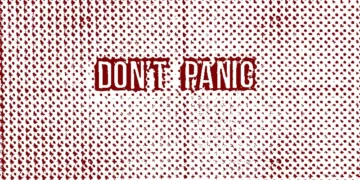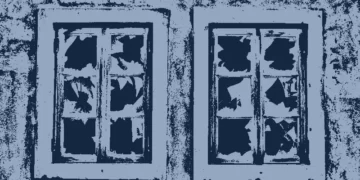Carpenter Brut are a synthwave band who utilise a 1980’s imaginary. Known for their array of homages to horror films of the 1980’s in particular, they have become perhaps the leading band in the synthwave spectrum of music genres. I want to pay attention however, to their music video for the track ‘Inferno Galore’ which comes from their 2018 album ‘Leather Teeth’. The video features a raft of references framed in a seemingly comical manner to satanism, heavy metal, abuse, religion, and the classic trope of records being played backwards. However, rather than simply being a compilation of comical imagery, they do in fact have a very real sociological history in what became known as the ‘satanic panic’. Watch the video first.
Carpenter Brut: Inferno Galore
Contains minor images of drug use, violence, and sex as well as references to abuse.
Is Your Child Satanic?
The video opens with the question ‘Is Your Child Satanic?’. What follows from this are a series of supposed warning signs that your child is involved in satanism or is a victim of satanic ritual child abuse: wearing black clothes and leather jackets, unnatural hair colour, listening to heavy metal, playing video games, watching horror films, smoking the devil’s lettuce (cannabis), watching ‘oriental cartoons’ (hentai anime), and playing role-playing games (Dungons & Dragons). During the 1980’s satanic panic, these were considered to be actually existing ‘symptoms’ of the presence of satanism.
The video is also cut with both invented images and symbolism of the band but also of real-world religious events. For example, at exactly 1 minute into the Carpenter Brut video, we see a series of shots showing people being ‘manhandled’. One of these is the real-world televangelist Benny Hinn who can be seen here and who really has to be seen to be believed.
Moral Panics
Although the phrase ‘satanic panic’ has a nice ring to it, the panic really refers to a moral panic, the concept of which was popularised academically by Stan Cohen in his 1972 book Folk Devils and Moral Panics. Based on Cohens PhD thesis, the moral panic was very much a product of its time when various kinds of deviance were being popularised in sociology such as delinquency, hooliganism, subcultures, and vandalism.
Cohen describes a moral panic as when:
a condition, episode, person or group emerges to become defined as a threat to societal values and interests
There have been many events which have been framed as moral panics including both the subject of this article – the satanic panic, Stan Cohens own mods & rockers panic, but also flag burning, paedophiles, single mothers, immigrants, terrorism, and dangerous dogs. What makes the satanic panic interesting is the sheer number of areas that it covered, essentially creating a number of interlinking moral panics around Dungeons & Dragons, horror films, heavy metal, child abuse, video games, anime, and even the NSPCC were drawn into it so it was not limited to a US phenomenon.
Dungeons & Dragons
Joseph Laycock in the book ‘Dangerous Games: What the Moral Panic Over Role-Playing Games Says About Play, Religion, and Imagined Worlds’ recalls his time living in Texas as a young person. Being into the new game of the time, Dungeons & Dragons, he describes how journalists such as Geraldo Rivera as well as individuals like Tipper Gore, the former second lady of the US, would proclaim that this new game was causing young people to go insane, worship the devil, and commit suicide. Further, Laycock notes the contradiction between young people being viewed as losers on the one hand, and dangerous satanists on the other. This in itself unveils the lack of logic inherent to a moral panic. Laycock locates the origins of this panic within both conservative politics and the New Christian Right who saw role-playing games as a serious threat to morality.
The video below is a short documentary outlining the manifestation of the satanic panic in relation to Dungeons & Dragons.
Heavy Metal
Heavy metal music has always had an image of satanism that it has either been unable to shake off or has embraced and exploited at will. Iron Maiden for example, since the release of their 1982 album ‘The Number of the Beast’, have been relentlessly followed by religious groups for 40 years. These groups often approach fans at concert queues asking them to repent and turn away from the devil. Even as recently as 2021, there was a campaign to remove a school principle in Ontario, who was an Iron Maiden fan, for showing “her allegiance to satanic practices”. Of course, ‘metalheads’ are often stereotyped by their wearing of leather jackets, black clothes, and unnatural hair colours as noted in the Carpenter Brut video.
Severe Consequences
Although some of this may seem silly to many, there were actually severe consequences for some. The satanic panic made its way into notions of ritualised child abuse. Originating in claims of ‘recovered memories’ using psychiatric treatments, the book Michelle Remembers became a pivotal source of satanic panic in relation to ritualised child abuse. In this book, a woman’s recovered memories reportedly consisted of experiences of ritualistic abuse and torture within a satanic cult.
Soon after, other reports began to emerge in children’s day care centres such as McMartin Day Care in California. This example led to the most expensive court case in US history at the time when the director, relatives, and workers were arrested under ritual abuse claims. As Mary DeYoung notes, many other centres were drawn into the panic going as far as young children being called as witnesses in court to testify against day care staff and making accusations of blood drinking and cannibalism. Yet, despite there being a complete absence of any evidence, day care workers were still jailed under harsh sentences.
Eventually, the satanic panic made its way to the UK in 1990 when the NSPCC began to disseminate warning signs of satanic ritual abuse. Rosalind Waterhouse, an investigative reporter and academic who has followed this phenomenon for three decades and is perhaps the undisputed expert in this area, outlines a number of occasions where children were forcibly taken into care; 41 children nationally, and later another 20 children in Rochdale, all the while there was no evidence that satanic ritual abuse had ever taken place.
Carpenter Brut
Carpenter Brut’s ‘Inferno Galore’ music video then, presents us with a satirisation of the satanic panic era replete with the whole 1980’s aesthetic. The moral framing of right-wing conservative Christians permeates throughout. Themes of sex, violence, and drugs are framed as immoral whilst the symbolism of pentagrams and magic remind us of evil’s presence. Heavy metal lyrics and murder, satanic abuse in the basements of heavy metal record stores, and faceless accusers of ritual abuse reflect the era. Later in the video, the request for religious boot camps to help rid children of the devil are shown essentially hinting at the militarism of the conservative Christian right.
An attack on a moral hypocrisy is present throughout. An ‘intermission’ whereby adverts are shown requesting excessive charges for religious packages of seminars, T-shirts, and healing. Money again makes its moral hypocrisy known by making requests to call an extortionately priced phone line. Carpenter Brut then, relentlessly juxtapose the creation of the satanic panic against an underlying theme of profit suggesting a manufactured panic for the generation of money.
Whether this is the case or not is unknown, but the satanic panic was certainly located within religious moralising. However, it shows just how far illogical occurrences lacking in any evidence can be taken. If lawyers, courts, religious officials, and childcare professionals can all be moved to take action based on a set of guidelines issued by power, what else can they be driven to do? It almost seems to reflect the events of the infamous Stanley Milgram experiment into obedience. That these individuals, in a multi-professional capacity, will still dish out punishments without evidence shows that people can be pushed to do anything.
As for Carpenter Brut, well, they are likely just enjoying the show.
References
Cohen, S. (2011). Folk devils and moral panics: the creation of the Mods and Rockers. Routledge classics. Abingdon, Oxon New York: Routledge.
DeYoung, M. (1997). The devil goes to day care: McMartin and the making of a moral panic. Journal of American Culture, 20, 19-26.
Laycock, J. (2015). Dangerous games: what the moral panic over role-playing games says about play, religion, and imagined worlds. Berkeley: University Of California Press.
Smith, M. and Pazder, L. (1981). Michelle Remembers. New York: Pocket Books, 1981; Markham, Ont.: PaperJacks.












